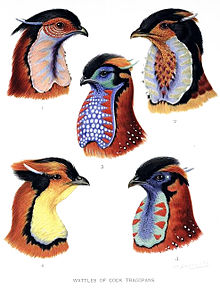Tragopane
| Tragopane | ||||||||||
|---|---|---|---|---|---|---|---|---|---|---|

Blythtragopan ( Tragopan blythii ) |
||||||||||
| Systematics | ||||||||||
|
||||||||||
| Scientific name | ||||||||||
| Tragopan | ||||||||||
| Cuvier , 1829 |
Tragopans or Satyrhühner ( Tragopan ) form within the family of pheasant-like a five kinds comprehensive genus with numerous special in body type and lifestyle.
features
Tragopane are strongly built birds with short bills. Their wings are rounded, with the first wrist arm shorter than the tenth and considerably shorter than the second. The fourth or fifth hand swing is the longest. The tail consists of 18 feathers and appears wedge-shaped when viewed from the side. Tragopane have a pronounced sexual dimorphism . The roosters are brightly colored, with red, brown and black predominating. The full adult plumage is formed in the second year of life. The roosters have short spurs. On both sides of the head they have cones of meat that can be erected by erectile tissue , and on the throat they have a lap-like, thinly feathered and brightly colored, swellable skin. The plumage color of the females is dominated by shades of brown.
distribution and habitat
Dense, moist mountain forests at altitudes between 1000 and 4000 meters form the preferred habitat of the tragopane. Their distribution area extends from the Himalayas to the mountains of northern Burma and central and southern China.
Way of life
Tragopane live in pairs. They are very shy, watchful and difficult to spot in their habitat. Tragopane often stay in the branches of trees, where they not only look for food, but also breed. The hen takes over the construction of the nest, which is lined with branches and leaves. Occasionally, abandoned crows or raptors' nests are also used. The roosters start courting in March. The horn-like meat cones and the throat are briefly displayed. The hen lays a total of three to six cream-colored, brown-speckled eggs every two days, from which chicks with relatively well-developed wings hatch after 28 days of incubation by the female. The diet of the tragopane consists mainly of parts of plants such as buds and leaves. Berries, seeds and insects are also ingested in smaller quantities.
species
There are five types :
- Black- headed tragopan ( T. melanocephalus )
- Cabottragopan ( T. caboti )
- Temmincktragopan ( T. temminckii )
- Blythtragopan ( T. blythii )
- Satyrtragopan ( T. satyra )
Attitude in human hands
All five species were first introduced to Europe between 1864 and 1882 by W. Jamrach. All species have already been successfully drawn. Satyr and Temmincktragopan are held relatively frequently today. Offspring can become quite trusting towards their keeper.
literature
- Jean Delacour: The Pheasants of the World. 2nd edition, Hindhead 1977, ISBN 0-904558-37-1
- Heinz-Sigurd Raethel , Curt von Wissel and Max Stefani: Pheasants and other chicken birds. 2nd edition, J. Neumann-Neudamm, Melsungen 1976, ISBN 3-7888-0225-1
- Franz Robiller: The great lexicon of bird care. Volume 2. Ulmer, Stuttgart 2003, ISBN 3-8001-3195-1
- The Modern Animal Lexicon , Bertelsmann Publishing Group, Volume 3, 1981
